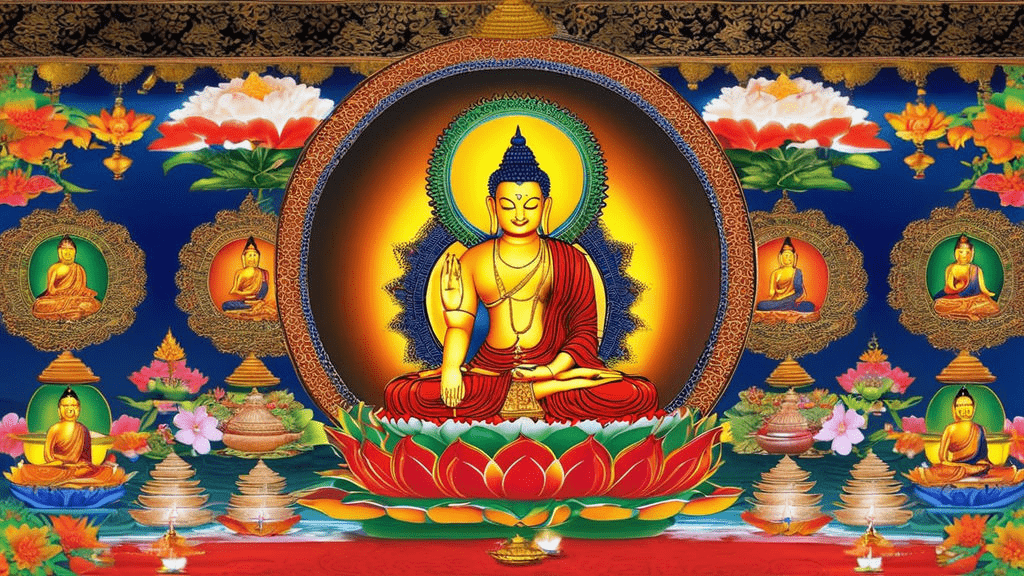Index of Contents
ToggleIntroduction:
In recent years, some modern Buddhist practices have strayed far from the original teachings of the Buddha. While innovation isn’t necessarily bad, certain bizarre and flashy rituals and beliefs could leave the Buddha scratching his head. This post examines some of the most peculiar modern practices and how they diverge from the Dharma.
The term “bizarre rituals” refers to practices within modern Buddhism that are considered strange or unconventional.
These rituals may involve elaborate ceremonies, chanting, or the use of specific objects or symbols. While rituals can be a meaningful part of religious practice, some modern Buddhist rituals may lack a clear connection to the original teachings of the Buddha. Similarly, some ideas or concepts within modern Buddhism that may be considered unusual or far-fetched may include supernatural or mystical elements that are not explicitly mentioned in the original teachings of the Buddha.
The Dharma serves as a guide for Buddhist practitioners, providing a framework for understanding suffering, the path to liberation, and the nature of reality. When modern Buddhist practices deviate from the Dharma, they may lose sight of these core teachings and principles. This divergence can lead to a misunderstanding or misinterpretation of Buddhism, potentially diluting its essence and distorting its original message. It is important for practitioners and scholars of Buddhism to critically examine these modern practices and assess their alignment with the core teachings of the Buddha.

Key Takeaways
- Some modern practitioners have misunderstood the Buddha’s teachings on enlightenment, wrongly pursuing supernatural powers or expecting instant enlightenment instead of gradual wisdom and compassion through practice. This diverges from the Buddha’s message.
- Commercialization of Buddhism through expensive retreats, selling of blessings and artifacts, etc. contradicts the Buddha’s teachings on non-attachment and avoiding greed. The Buddha discouraged profiting from faith.
- Superficial adoption of Buddhist motifs for social status, without understanding their meaning, overlooks the tradition’s purpose. Respectful integration is good, but the Buddha would be concerned by appropriation devoid of meaning.
- While innovation isn’t inherently bad, modern practices should be examined wisely to ensure they align with the Buddha’s teachings, avoiding extremes of blind traditionalism and reckless innovation.
- The essence of Buddhism remains transforming oneself through wisdom, ethics and compassion. Rituals, symbols and social status are secondary to internal change.
Misconceptions About Enlightenment
Some modern practitioners have misconstrued the Buddha’s teachings on enlightenment, pursuing supernatural powers as the goal rather than wisdom and compassion. They believe enlightenment leads to omniscience, when in reality it is simply freedom from delusion. Others think enlightenment happens instantly like a light switch, rather than gradually through sustained practice. These misguided views overlook the Buddha’s message that the path to enlightenment requires ethical conduct, mental purification, and insight into the nature of reality. Pursuing magic tricks or expecting overnight transformation would have perplexed the Buddha.
It is crucial to always keep the fundamental principles of the Buddha’s teachings in mind when embarking on the noble journey towards enlightenment. The profound wisdom and boundless compassion advocated by the Buddha constitute the cornerstone of attaining genuine understanding and breaking free from the shackles of illusion, without veering into a quest for mystical abilities. The enlightening path entails a meticulous progression that encompasses ethical behavior, mental clarity, and deep revelations about the essence of existence through dedicated practice. This comprehensive approach not only upholds the essence of the Buddha’s profound message but also serves as a beacon directing aspirants towards an authentic and profound transformation.
In conclusion, embracing the fundamental principles of the Buddha’s teachings is essential for those seeking enlightenment. By prioritizing profound wisdom and boundless compassion over mystical pursuits, individuals can attain genuine understanding and break free from illusions. The enlightening path involves a meticulous progression encompassing ethical behavior, mental clarity, and deep revelations about existence through dedicated practice. This comprehensive approach not only upholds the essence of the Buddha’s message but also guides aspirants towards an authentic transformation. Embracing these principles paves the way for a profound journey towards enlightenment and self-realization.
Commercialization of Buddhism and flashy rituals
In recent decades, some have commercialized Buddhist practices in ways that seem at odds with the Buddha’s teachings on non-attachment and avoidance of greed. Expensive retreats marketed as an opportunity for luxury more than practice would likely concern the Buddha. So too would the selling of blessings, healing rituals, and supposedly holy artifacts like mala beads and statues. The Buddha discouraged profiting from faith and taught that spiritual development cannot be bought. Much modern commercialization also promotes pursuing external symbols of enlightenment rather than doing the hard work to attain it.
It’s important to remember that true enlightenment comes from inner growth and practice, rather than material possessions or expensive retreats. The Buddha’s teachings emphasize the importance of sincerity and genuine effort in one’s spiritual journey, rather than seeking quick fixes or external symbols of enlightenment.
It’s essential to stay true to the core teachings of Buddhism, focusing on inner growth and spiritual development rather than materialism or commercialization. The essence of Buddhist practice lies in sincerity, genuine effort, and a deep commitment to one’s spiritual journey. By recognizing this and maintaining authenticity in our approach, we can truly embody the teachings of the Buddha and experience genuine enlightenment.
Adhering to the fundamental principles of Buddhism, centered on inner transformation and spiritual advancement over materialistic pursuits, is paramount. The core values of sincerity, dedicated effort, and unwavering devotion to personal growth are pivotal in embodying the essence of Buddhist teachings. By upholding these principles with authenticity and a genuine spirit, individuals can fully embrace the wisdom of the Buddha and attain true enlightenment through their spiritual journey.
Cultural Appropriation
Some adopt Buddhist motifs like tattoos or fashion accessories without much understanding of their religious significance. Taking practices out of context, like meditation apps that promote “mindfulness” devoid of ethics, also diverges from the Buddha’s message. Treating Buddhism as a trend or status symbol, rather than a complete philosophy for living, overlooks the tradition’s deep purpose. Respectfully integrating Buddhist principles into other cultures is admirable, but superficial adoption for social capital would seem misguided to the founder.
It’s important to honor the rich history and profound significance of these practices, rather than reducing them to mere trends or accessories. Authentic understanding and meaningful integration of Buddhist principles can bring true value to one’s life. Thank you for raising awareness about the importance of approaching these teachings with sincerity and reverence. Honoring the deep-rooted history and profound significance of practices like Buddhism is crucial for truly benefiting from their wisdom. By approaching these teachings with sincerity and reverence, we can integrate them meaningfully into our lives to find true value and growth.
In conclusion, it is essential to honor the rich history and profound significance of practices like Buddhism, rather than trivializing them as passing trends or accessories. By authentically understanding and integrating Buddhist principles into one’s life with sincerity and reverence, true value can be derived. Raising awareness about the importance of approaching these teachings with respect is crucial for benefiting from their wisdom. Honoring the deep-rooted history and significance of such practices is key to meaningful integration in our lives, leading to genuine growth and enrichment.
FAQ
- Question 1: What are some modern Buddhist practices that might seem bizarre or divergent from original Buddhist teachings?
- Answer 1: Some examples could include: extreme ascetic practices like self-mummification, practices that encourage social isolation over compassion, using Buddhist imagery in pop culture in ways that seem at odds with Buddhist ethics, participating in rituals or ceremonies not traditionally associated with Buddhism, and anything that seems to contradict core Buddhist principles like non-violence and moderation.
- Question 2: Why might some modern Buddhist practices diverge from ancient Buddhist texts and traditions?
- Answer 2: There are a few potential reasons. As Buddhism has spread globally, it has adapted to new cultures and perspectives. Some divergences may come from misinterpretations or misunderstandings of complex philosophical concepts. In other cases, ancient texts and traditions may be reinterpreted or even dismissed in an attempt to modernize the religion. Some practices stem from blending Buddhism with other faiths or New Age ideas. And in some cases, divergent practices arise from people exploiting Buddhism for profit or power.
- Question 3: How can lay Buddhists thoughtfully examine the traditions and rituals they participate in?
- Answer 3: Lay Buddhists should examine any rituals or practices in light of the core Buddhist principles of wisdom, ethical conduct, generosity, patience, perseverance and mindfulness. Traditions that encourage greed, hatred, delusion or harm should be reconsidered. Studying sutras and consulting monastics or teachers can provide guidance. But ultimately each practitioner must use their own discernment to determine if a practice supports their spiritual growth.
- Question 4: What are the risks of adopting practices or beliefs that diverge from mainstream Buddhism?
- Answer 4: Some risks include developing misconceptions about the Buddha’s teachings, clinging to practices not truly conducive to enlightenment, justifying unethical conduct, alienating oneself from the larger Buddhist community, and failing to benefit from the wisdom passed down in ancient texts and traditions. However, some divergence isn’t necessarily problematic if examined carefully.
- Question 5: When does divergence become problematic or undermine the goals of Buddhist practice?
- Answer 5: Divergence tends to become problematic when it contradicts basic Buddhist principles of ethical conduct and wisdom, justifies harming oneself or others, stems from greed or ego rather than compassion, or leads one to become closed-minded, judgmental or isolated. As long as practices encourage skillful living, mental purification, compassion and insight, divergence from tradition isn’t necessarily an issue. But practices based in delusion should be reconsidered.
Conclusion:
While Buddhism has adapted to new cultures, it’s important not to lose sight of the Buddha’s original teachings. The point isn’t flashy rituals or status symbols but rather internal transformation through wisdom and compassion. With an open yet discerning mind, we can separate skillful innovations from mere spiritual materialism. The divergences above should not wholly discourage modern practice but rather remind us to walk the Middle Path. As the Buddha taught, we can avoid the extremes of blind traditionalism and reckless innovation by staying grounded in the Dharma’s essential principles. With insight and sincerity, its liberating message remains as relevant today as ever.
It’s crucial to maintain a focus on internal transformation through wisdom and compassion rather than getting caught up in external displays or materialistic pursuits. By approaching practice with an open yet discerning mind, we can navigate skillful innovations while avoiding spiritual materialism. Remembering to walk the Middle Path is key, as it allows us to steer clear of extremes like blind traditionalism or reckless innovation. Grounding ourselves in the essential principles of Dharma, as taught by the Buddha, helps us stay connected to the timeless wisdom that continues to offer liberation and relevance in our modern world.
In conclusion, by prioritizing internal transformation guided by wisdom and compassion over external displays or materialistic pursuits, individuals can navigate skillful innovations while avoiding spiritual materialism. Embracing the Middle Path is essential to steer clear of extremes like blind traditionalism or reckless innovation. Grounding in the timeless principles of Dharma as taught by the Buddha allows for staying connected to wisdom that offers liberation and relevance in our modern world.



